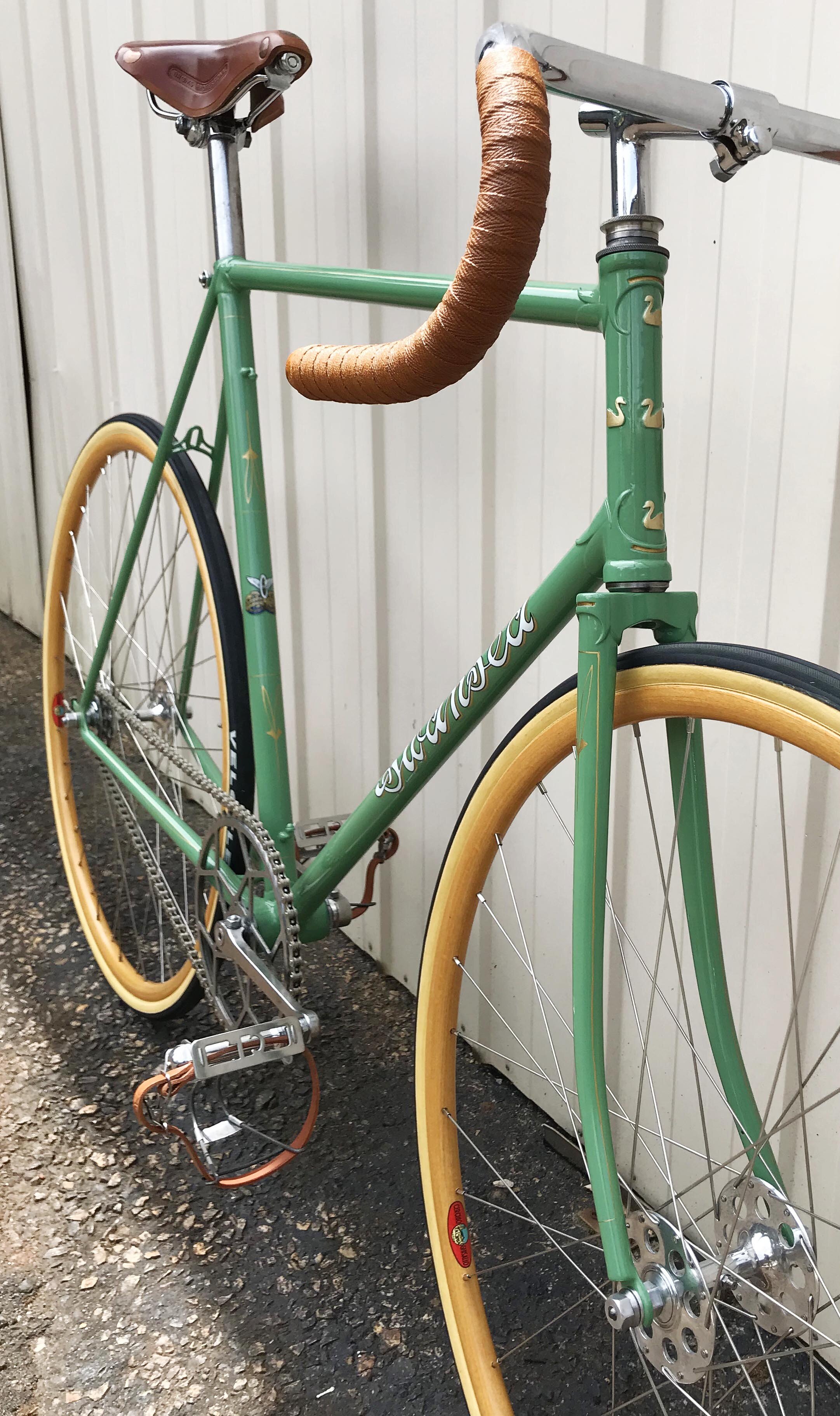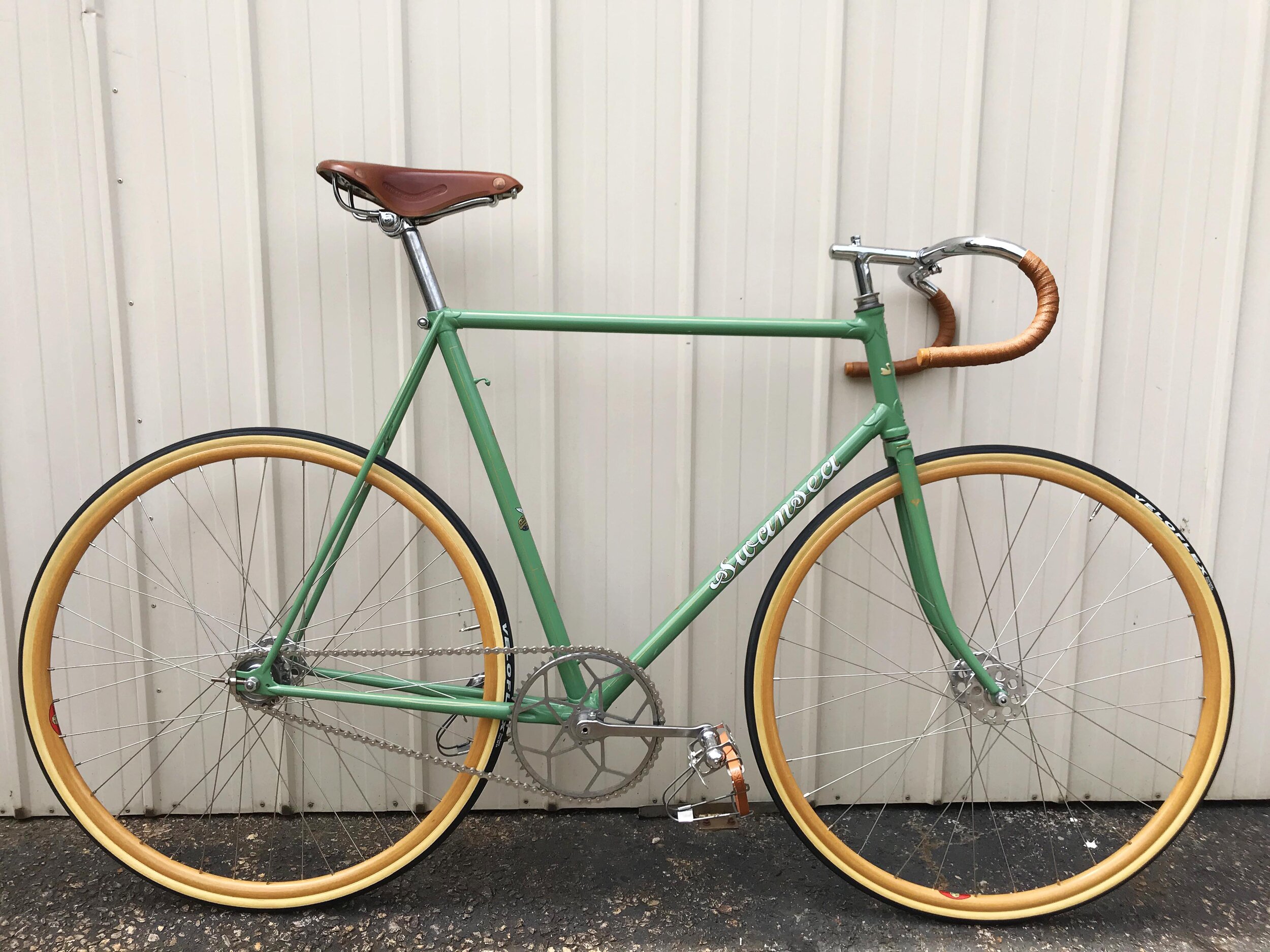Five Sparkling Swans
Never look a gift horse in the mouth, particularly when the thoroughbred in question is a Swansea 5-Swan. I was extremely grateful to be offered this racehorse as a restoration project. However, the old girl required a fair bit of dentistry to bring her out of retirement.
This Swansea is a 1941 model. A large frame with a 23.5 inch seat tube. The geometry suggested a track heritage, with a steep head angle of 78 degrees. The seat angle is relaxed at 70 degree, common for the day.
When I received the bike in 2014, it appeared rideable. The 52t Williams chain set, hollow TDC bottom bracket axle, Brampton headset and dome top seat post were clearly original, so were preserved, polished and remain on the bike today. The other components were modern add-ons, and were given away. The wheels went to another Swansea restoration project, and got that bike back on the road. That small gift repaid itself many times over, but more on that later.
The frame was powder coated yellow when I got it. This thick lacquer had done a good job of protecting the frame from the ravages of coastal living for many years. However, it also hid a troubled past. Close inspection revealed a bent top tube. The ATP stem, almost certainly original to the bike, was also twisted. Gentle sanding of the top tube revealed crash damage, a handlebar strike to the top tube, maybe a racing accident on a velodrome. The large dent had been well repaired with braze, but the frame was twisted. Shot blasting to remove the rest of the powder coat found further damage. There was long crack through the length of the indent in the non-drive chain stay. The frame was now clearly unrideable.
I now found myself at that well know fork in the road of restoration. We have all been there and the choice can be difficult. Turn left for preservation, or right for complete reconstruction. With the frame bent, cracked, and with no original paint to left save, the direction was clear…I put her out on the curb for the hard waste collection.
Only joking. A bike like this was too important. So I began the process of trying to discover what a new Swansea would have looked like in 1941. What components were needed to get this bike back to “As new” condition? I also sold one of my kidneys.
Original printed information about Swansea is not easy to come by, particularly regarding paint. I visited quite a few Swansea’s with original paint, to get some ideas, but their art deco styling wasn’t for me. I did have some luck along the way though. During a visit to see the Swansea at Mercer Cycles in Freo, I got chatting with the owner. He was selling a collection of vintage bike parts for a friend, and let me buy an identical pattern ATP stem and handlebar to replace the damaged one that came with the bike. After a further six months of getting nowhere, a chance conversation at the club house changed everything. A guy living a few streets from me was after a pair of wheels for a Swansea he had just found. I offered him my wheels and we arranged to meet. It was love at first sight…not with Gary, but with the paintwork on his bike.
Things were moving again now. Peter Campbell carefully repaired the frame. The top tube and chain stay were replaced. Also, the drunken attempt to drill a hole in the fork crown for a front brake was filled. Cameron Smith resprayed the frame and hand painted the pin stripes and artwork, copying the original design from Gary’s bike.
The search for components was now focused on wheels. Another six months of eBay watching went by, but no Australian made hubs came into VEW. So I settled on a pair of drilled Harden “bacon slicers”. I had read somewhere that 500 pairs of these were exported to Australia, and that was good enough for me. I had my heart set on wooden rims, so a pair of Cherchio Ghisallo pista rims were ordered from Italy. These are still made by hand in the traditional way on the shores of Lake Como. Poetry to my ears and eyes, but doggerel to my wallet.
Harden Hubs are drilled for 15g spokes, but these are not easy to find in Australia. The thought of drilling out the hubs to 14g was too frightening. So I called on some old friends in the UK to help me out. Soon, shiny new stainless steel 15/17g double butted DT Swiss spokes had made their journey half way around the world to my shed. When they arrived they didn’t fit. They seemed to be too long. I was furious with myself. What had I done wrong? Ghisallo rims are supplied with special 1 inch nipples, longer than usual, to pass right through the thicker wooden rim. But what I hadn’t realised was that these nipples also have an unusually long 15mm internal thread. Standard DT Swiss nipples have an 8mm internal thread. DT Swiss spokes have a 10mm thread. I had measured up for a standard wheel build, with the spoke ends aiming to reach the nipple head. But this could not happen with the longer nipples, as the extended internal thread fouled the spoke, locking them up 5mm short of the nipple head. Having struggled to get any spokes at all, I decided to drill out the extra 7mm of thread from the inside of each of the 72 long nipples, a task I performed with a Dremel and X-rated language. In the end, the decision was a good one. In fact, the spokes were the correct length, and the wheel build was easy after that. The rear wheel was finished with an 18t BSA sprocket to give a reasonable gear.
The bike is dressed with gum walled tubulars, a honey coloured Brooks Professional saddle, a Brooks chrome seat clamp, Chater Lea Sprint pedals and Brooks leather toe straps. Newbaum yellow cotton bar tape was treated with about 25 coats of shellac (pre-mix bottle from Bunnings), until the colour matched the saddle. Cork bar ends came from the local brewing shop, only requiring a little bit of shaping for a good fit. These were also coated with shellac. New old stock 1940s chain tugs secure the rear wheel. Custom machined T-washers secure the front hub in the keyhole front fork dropouts. A modern silver chain was a practical choice, but looks fine. For a final flourish, and to complete this patriotic green and gold Swansea, the toe clips are Cyclo Oppy.
The build has taken 5 years, on and off. The majority of the time was spent worrying about the correct thing to do. Some would say just ride it, and they have a good point; that is what a bike is for. But I felt a strong sense of responsibility to this bike, to the previous owner, to its history, to get it right… whatever that might mean. The bike now lives in the house; a stable is no place for a thoroughbred like this.
Will Bugg



